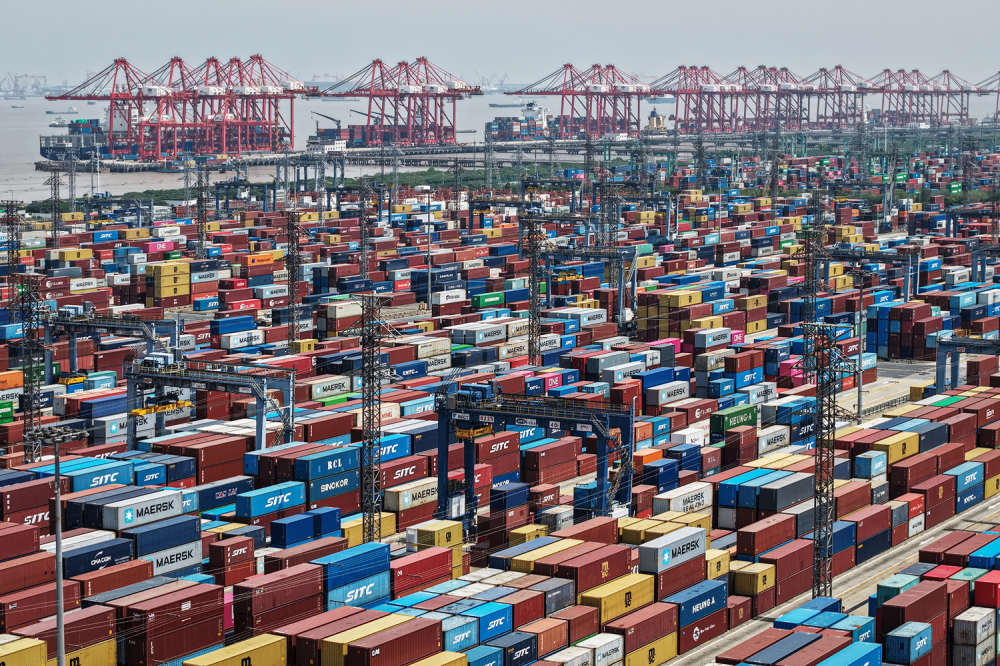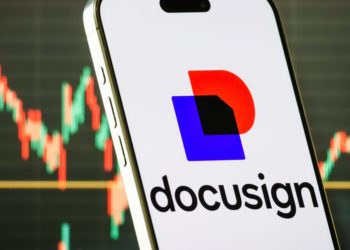In an inflation-anxious United States, a Chinese app named after a Silk Road city briefly became the second-most downloaded app last week—trailing only behind ChatGPT. It’s not for artificial intelligence. It’s not for gaming. It’s for handbags. DHgate, known as Dunhuang in Chinese, is a two-decade-old cross-border e-commerce platform that’s suddenly gone viral. American consumers, squeezed by looming price hikes triggered by escalating tariffs, are flocking to it for bargain yoga pants and Hermès dupes.
On TikTok, influencers are touting Dunhuang as the place to get Hermès-style bags “without playing the Hermès game,” claiming that many luxury goods are made in the very same Chinese factories. Behind the scenes, the app is launching a “tariff escort plan” to help its merchants ride the wave of demand. American shoppers are probing for workarounds—chasing bargain Chinese goods one download at a time.
The Dunhuang phenomenon isn’t just a quirky tale of a Chinese app enjoying its 15 minutes of fame. It’s a mirror reflecting the deepening complexity of global commerce—and how policy tools are forever chasing, and lagging behind, the new realities that it creates.
Tariffs were meant to penalize unfair trade practices and shift supply chains. But in practice, they’ve made domestic shopping more painful—exposing just how unaffordable prices have become in the United States. And the reason that consumers are turning to foreign platforms isn’t ideology—it’s arithmetic.
Even with tariffs reaching as high as 145 percent on some Chinese goods, Americans are still buying—not from Walmart or Amazon, but directly from Chinese suppliers on apps such as Dunhuang. To be clear, the platform doesn’t help consumers evade tariffs—duties still apply. But what it offers is a way to offset them. By skipping brand markups, wholesalers, and traditional retail intermediaries, Dunhuang users can still score products at a fraction of U.S. prices—even after shipping costs and import duties are baked in.
For instance, apparel markups in the United States often range from 100 percent to 300 percent, and accessories can see markups as high as 350 percent. Additionally, logistics costs—encompassing warehousing, transportation, and distribution—can add another roughly 40 percent to the final price. By eliminating these layers and brand premium, Dunhuang offers consumers significant savings—savings that are simply too dramatic to ignore. Counterfeits? Customs delays? These worries pale in comparison to the one truth that the trade war made unavoidable: The price gap hasn’t closed—and may not anytime soon. If anything, tariffs have made domestic shopping more painful in the short term, revealing an uncomfortable economic truth that policy alone can’t disguise: For a growing share of Americans, domestic prices are simply out of reach.
That price gap remains stark: A U.S. handbag can cost 20 times more than a near-identical one in Guangzhou. Labor costs don’t explain it—Chinese wages have risen, but they still trail U.S. levels. Dunhuang isn’t bypassing tariffs; it’s bypassing everything else—branding, markups, and middlemen whose value is increasingly in question.
Yet behind the sleek surface of direct-from-factory bargains lies a far murkier infrastructure. Dunhuang’s core model was never built for retail. It is a business-to-business platform, with limited capacity to resolve customer complaints, manage delivery expectations, or uphold global standards for consumer protection. As its popularity surges among U.S. users, so does the risk of legal backlash.
The platform is already drawing scrutiny for selling imitation goods that blur the line between “dupes” and outright counterfeits. Intellectual property violations aren’t a bug of the system—they’re often a feature. And that puts the app squarely in Washington’s crosshairs: Intellectual property (IP) protection and enforcement remain a top U.S. concern in its broader trade dispute with China. DHgate has previously appeared on the U.S. Trade Representative’s “notorious markets” watch list. That spotlight may soon turn punitive.
Until now, many purchases slipped through under the $800 de minimis threshold, avoiding import duties. That loophole narrows after May 2—but the broader cost gap remains. Even with tariffs, the savings are still enough to lure U.S. buyers.
As prices rise, consumers are shifting to TikTok links and shipping codes—tools of a more informal, less accountable ecosystem. It’s faster, cheaper—and riskier. Protections drop alongside prices. Once they click “buy,” consumers are often on their own to navigate delays, defects, and disputes across borders and platforms.
Sellers on platforms such as Dunhuang have learned to operate in the shifting gray zones of international commerce, staying just ahead in a cat-and-mouse game with regulators. Some of their most common tactics—fragmenting shipments, obscuring points of origin, routing goods through third countries—may no longer be viable soon. But the incentives that gave rise to those tactics haven’t gone away. And neither has the exporters’ instinct to adapt. New workarounds will almost certainly emerge, forcing regulators once again to play catch-up.
What makes this moment especially potent is how it’s been amplified by social media. Chinese suppliers began posting behind-the-scenes TikTok videos breaking down the real economics of luxury goods: “This Hermès bag? It costs $1,400 to make, sells for $38,000.” Paired with direct purchase links—clear signs of a broader marketing strategy—these videos didn’t just offer deals—they pulled back the curtain on how luxury goods are actually made and priced. Social media quickly filled with tutorials on how to shop Chinese factories directly, dodge customs flags, and spot top-tier “reps.” The effect wasn’t just viral—it normalized what had once been niche or fringe trade behaviors and pulled them into the consumer mainstream.
Yes, counterfeit goods are part of this equation, and that deserves scrutiny. There is something deeply problematic about a platform where knockoffs flourish and IP rights feel like suggestions. But the deeper issue is not that these goods exist—it’s that there is overwhelming demand for them.
Technology didn’t create that demand, but it amplified it. Social media, mobile payments, and cross-border apps have made finding and buying low-cost goods easier than ever. In today’s United States, when rent, groceries, and child care costs are all up, consumers aren’t necessarily setting out to break the rules; they’re trying to stretch every dollar. That desperation doesn’t excuse illicit purchases, but it helps explain the overwhelming demand for cheaper alternatives, no matter how murky the supply chain.
Still, for China’s export sector, the Dunhuang moment is no victory lap. It is an improvisation—a digital sleight of hand that buys time but solves little. The fundamentals are still worsening. Tariff hikes are whiplashing logistics chains. Order cancellations are mounting. Some U.S. retailers are pushing suppliers to cut prices by 30 percent and extend credit for months. Others are simply walking away.
Across China’s coastal export belt, small businesses are scrambling. Some are shifting inventory to local livestreams or dumping excess stock domestically. And increasingly, they are looking beyond the U.S. altogether—courting buyers in the Persian Gulf, Southeast Asia, and Latin America. But for smaller factories especially, this pivot is easier said than done.
The line between official and unofficial commerce is blurring, and traditional trade defenses are falling behind digital workarounds. If this reads like a policy nightmare, that’s because it is. For the better part of a decade, Washington has waged a campaign to stem the tide of cheap Chinese goods.
Platforms like Dunhuang have elevated compliance avoidance to an art form. And they didn’t do it in the shadows. They did it in plain sight—on TikTok’s “For You” page.
What needs to happen now isn’t just calling out bad actors from Chinese businesses. It’s a serious reckoning with the cat-and-mouse chase between restrictions and workarounds in global commerce: The system is evolving faster than traditional tools can adapt. Working-class Americans now share more in common with Chinese consumers—in their price sensitivity, their abandonment of legacy brands, and their distrust of big-name retailers—than they do with the fantasy of the affluent post-industrial shopper that many policymakers still legislate around.
China, for its part, has little cause for triumphalism. A model built on loopholes, gray zones, and proxy platforms may profit in the short term, but it cannot anchor China’s long-term ascent up the value chain. If Beijing truly aims to shape—not just survive—the future of global commerce, it must move beyond this game of regulatory whack-a-mole.
Sustained credibility in the next phase of globalization will not be won through viral tricks or tariff arbitrage. It will be earned by confronting the hard questions of quality, standards, and trust—especially in the very markets where political scrutiny is now most acute.
The post A Viral App Is Exposing the Limits of Tariffs appeared first on Foreign Policy.




